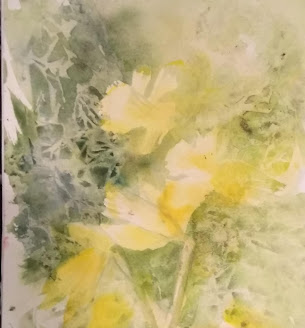As promised, here is the beginning of doing a pen and wash doing a wash first.
Step 1: Find a subject you are interested in painting. In this case it is sunflowers and daffodils.
Step 2: Do a wet into wet funwash, using the purest color of your main subject, plus a few analogous colors. (This is to keep the color fresh from the start)
Step 3: Make sure to leave lots of white.
In this one, I know I want to do some sunflowers, so I found a few references. I put the main yellow and orange and pink colors generally where I will position the flowers. But the color is other places also.
NEXT STEP; Lightly sketch in generally where some important shapes might be.
Then, with background colors (I used blues, pinks, and greens) I negative painted around some of the important shapes, WET INTO WET. While wet I put wrinkled plastic wrap over it and let it dry.
In this case, it is done twice because I couldn't keep the whole painting wet enough.
I'll finish that one later. This pic below shows what my daffodil picture looked like after the first steps.
I then found a number of daffodil references and drew in my composition with pencil. Then I inked the outlines. Please notice: My flower petals often are drawn right into green background. That's more than fine...it adds interest. I'm not trying to make perfect static looking flowers.
Now I begin to ink places that I want to have more definition or value. I mostly used
contour lines, going with the shapes of the petals and leaves. For most of the inner lines I used an 03 Micron black.
I like the way it turned out. And the process was fun. You do a lot of composition on the fly,
allowing the background to help make decisions about placement of objects.






No comments:
Post a Comment